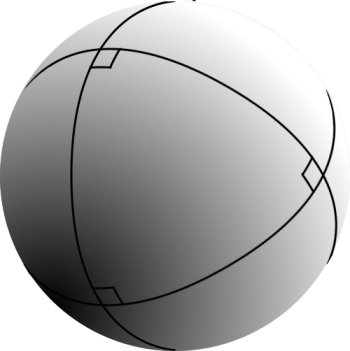|
Half-side Formula
In spherical trigonometry, the half side formula relates the angles and lengths of the sides of spherical triangles, which are triangles drawn on the surface of a sphere and so have curved sides and do not obey the formulas for plane triangles. Formulas On a unit sphere, the half-side formulas are. : \begin \tan\left(\frac\right) & = R \cos (S- A) \\ pt\tan \left(\frac\right) & = R \cos (S- B) \\ pt\tan \left(\frac\right) & = R \cos (S - C) \end where * ''a'', ''b'', ''c'' are the lengths of the sides respectively opposite angles ''A'', ''B'', ''C'', * S = \frac(A+B+ C) is half the sum of the angles, and * R=\sqrt. The three formulas are really the same formula, with the names of the variables permuted. To generalize to a sphere of arbitrary radius ''r'', the lengths ''a'',''b'',''c'' must be replaced with * a \rightarrow a/r * b \rightarrow b/r * c \rightarrow c/r so that ''a'',''b'',''c'' all have length scales, instead of angular scales. See also * Spherical law ... [...More Info...] [...Related Items...] OR: [Wikipedia] [Google] [Baidu] |
Spherical Trigonometry
Spherical trigonometry is the branch of spherical geometry that deals with the metrical relationships between the sides and angles of spherical triangles, traditionally expressed using trigonometric functions. On the sphere, geodesics are great circles. Spherical trigonometry is of great importance for calculations in astronomy, geodesy, and navigation. The origins of spherical trigonometry in Greek mathematics and the major developments in Islamic mathematics are discussed fully in History of trigonometry and Mathematics in medieval Islam. The subject came to fruition in Early Modern times with important developments by John Napier, Delambre and others, and attained an essentially complete form by the end of the nineteenth century with the publication of Todhunter's textbook ''Spherical trigonometry for the use of colleges and Schools''. Since then, significant developments have been the application of vector methods, quaternion methods, and the use of numerical methods. P ... [...More Info...] [...Related Items...] OR: [Wikipedia] [Google] [Baidu] |
Spherical Triangle
Spherical trigonometry is the branch of spherical geometry that deals with the metrical relationships between the sides and angles of spherical triangles, traditionally expressed using trigonometric functions. On the sphere, geodesics are great circles. Spherical trigonometry is of great importance for calculations in astronomy, geodesy, and navigation. The origins of spherical trigonometry in Greek mathematics and the major developments in Islamic mathematics are discussed fully in History of trigonometry and Mathematics in medieval Islam. The subject came to fruition in Early Modern times with important developments by John Napier, Delambre and others, and attained an essentially complete form by the end of the nineteenth century with the publication of Todhunter's textbook ''Spherical trigonometry for the use of colleges and Schools''. Since then, significant developments have been the application of vector methods, quaternion methods, and the use of numerical methods. ... [...More Info...] [...Related Items...] OR: [Wikipedia] [Google] [Baidu] |
Spherical Law Of Cosines
In spherical trigonometry, the law of cosines (also called the cosine rule for sides) is a theorem relating the sides and angles of spherical triangles, analogous to the ordinary law of cosines from plane trigonometry. Given a unit sphere, a "spherical triangle" on the surface of the sphere is defined by the great circles connecting three points , and on the sphere (shown at right). If the lengths of these three sides are (from to (from to ), and (from to ), and the angle of the corner opposite is , then the (first) spherical law of cosines states:Romuald Ireneus 'Scibor-MarchockiSpherical trigonometry ''Elementary-Geometry Trigonometry'' web page (1997).W. Gellert, S. Gottwald, M. Hellwich, H. Kästner, and H. Küstner, ''The VNR Concise Encyclopedia of Mathematics'', 2nd ed., ch. 12 (Van Nostrand Reinhold: New York, 1989). :\cos c = \cos a \cos b + \sin a \sin b \cos C\, Since this is a unit sphere, the lengths , and are simply equal to the angles (in radians) subten ... [...More Info...] [...Related Items...] OR: [Wikipedia] [Google] [Baidu] |
Law Of Haversines
The haversine formula determines the great-circle distance between two points on a sphere given their longitudes and latitudes. Important in navigation, it is a special case of a more general formula in spherical trigonometry, the law of haversines, that relates the sides and angles of spherical triangles. The first table of haversines in English was published by James Andrew in 1805, but Florian Cajori credits an earlier use by José de Mendoza y Ríos in 1801. (NB. ISBN and link for reprint of second edition by Cosimo, Inc., New York, 2013.) The term ''haversine'' was coined in 1835 by James Inman. (Fourth edition) These names follow from the fact that they are customarily written in terms of the haversine function, given by . The formulas could equally be written in terms of any multiple of the haversine, such as the older versine function (twice the haversine). Prior to the advent of computers, the elimination of division and multiplication by factors of two proved convenient ... [...More Info...] [...Related Items...] OR: [Wikipedia] [Google] [Baidu] |
